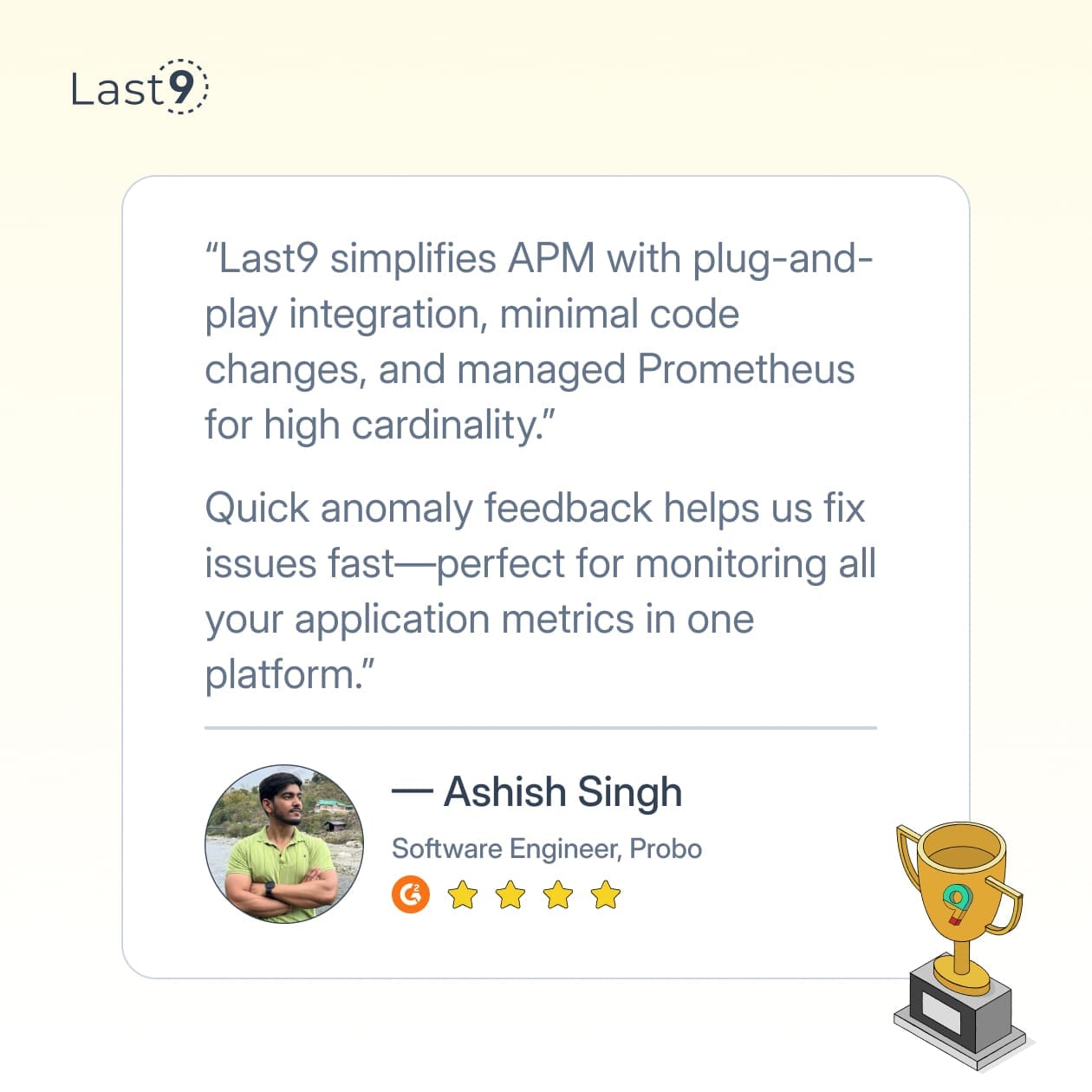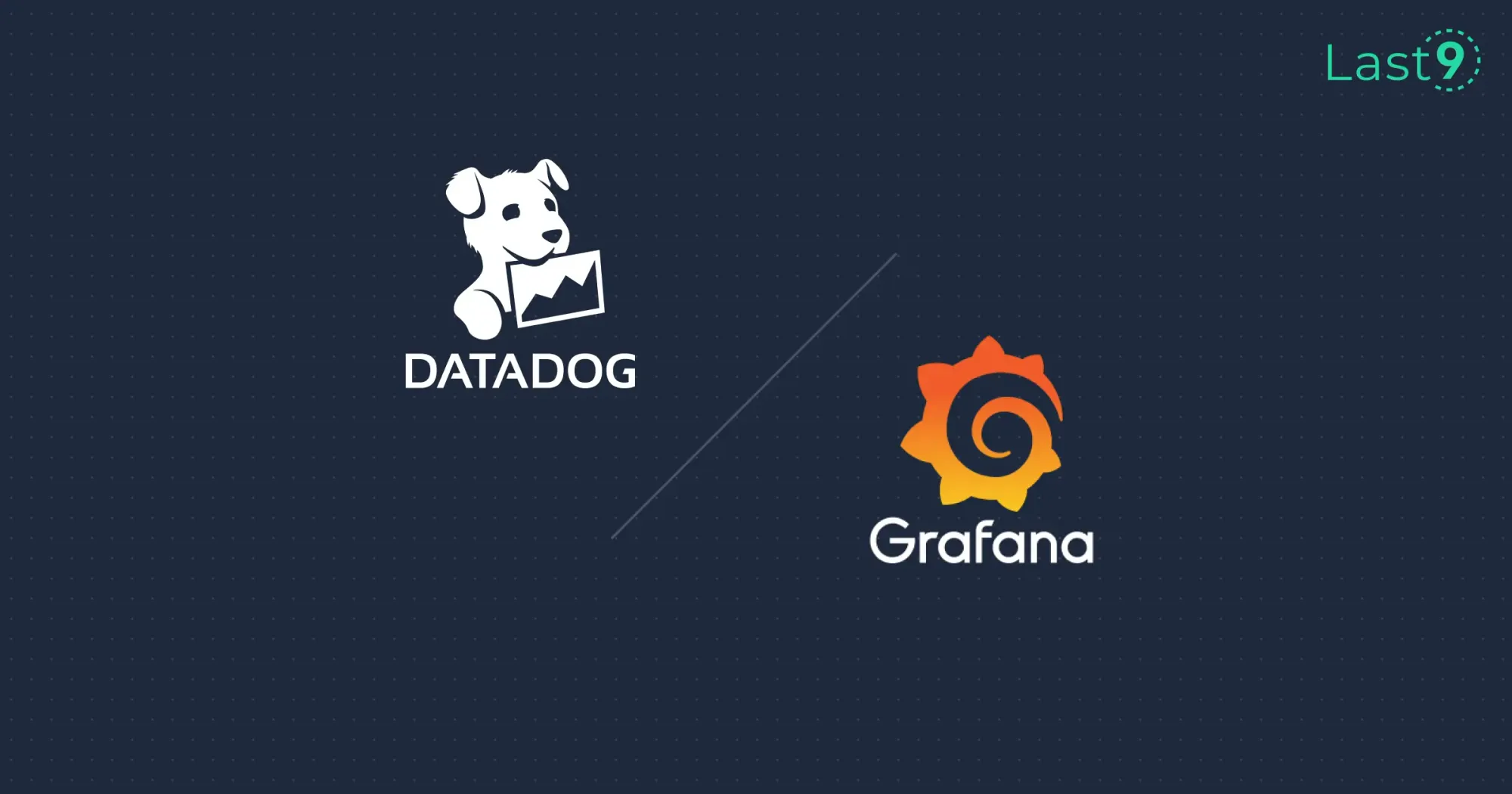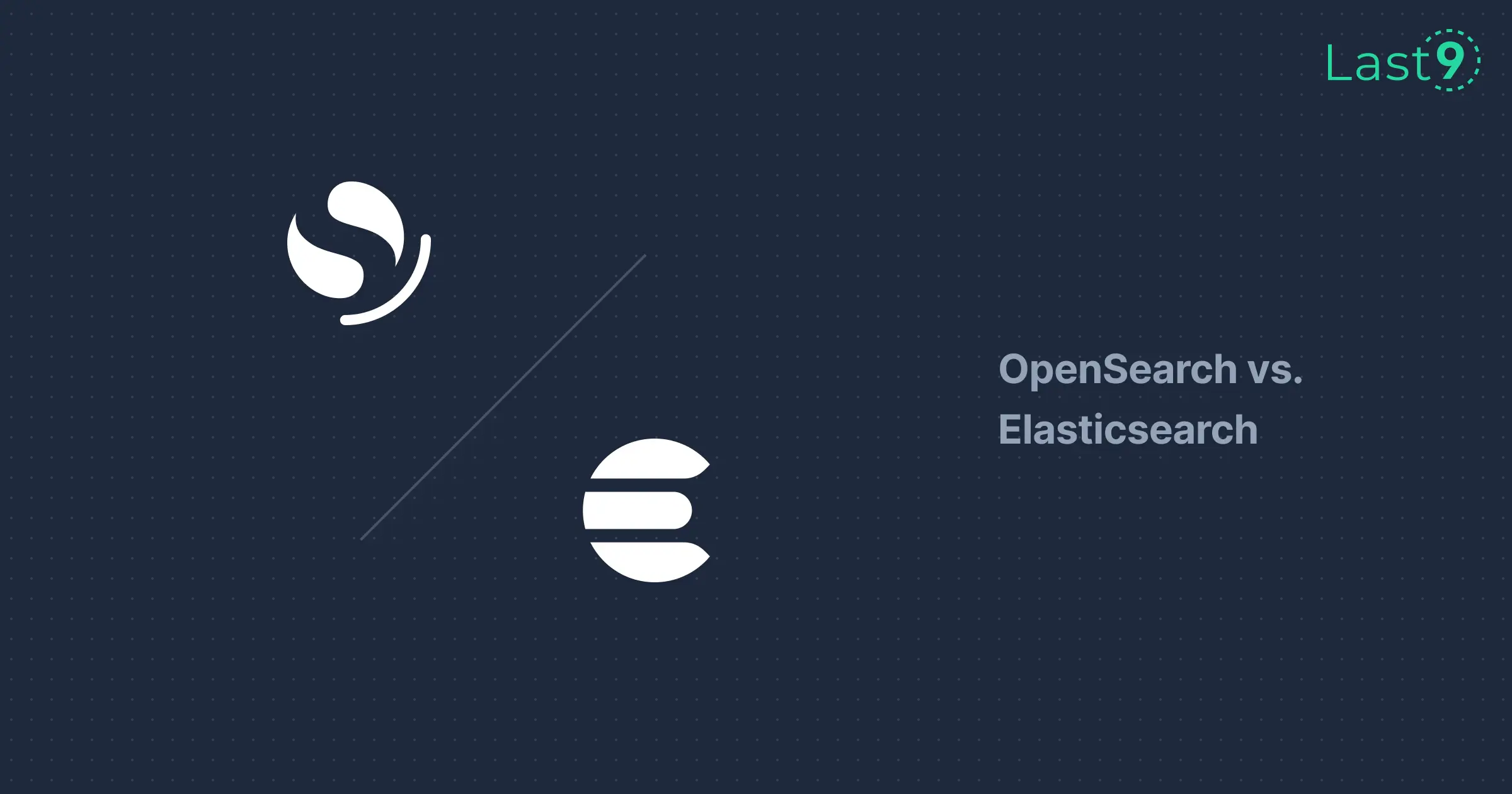Modern distributed applications generate massive amounts of telemetry data across microservices, containers, and cloud infrastructure. When performance issues arise—and they will—teams need immediate visibility into the root cause to minimize user impact and maintain system reliability.
Application Performance Monitoring (APM) provides this critical visibility by continuously collecting and analyzing application telemetry to identify bottlenecks, track errors, and optimize resource usage before issues escalate.
What is Application Performance Monitoring (APM)?
Application Performance Monitoring (APM) involves continuously collecting and analyzing telemetry data that reveals how your application performs during runtime. This includes three main types of data:
- Metrics such as response latency, error rates, throughput, and resource usage, like CPU and memory
- Traces that track the flow of individual requests across services
- Logs that capture detailed events and error messages
These signals provide a clear view of where and why application performance may be degrading. Examples include:
- P95 latency (95th percentile response time)
- Database query execution duration
- Garbage collection pauses
- Frequency of HTTP 5xx errors
APM functions as a health tracker for your application. Instead of monitoring pulse or oxygen levels, it focuses on these technical indicators to detect stress points. This continuous insight helps you quickly identify slowdowns, pinpoint the specific service or function responsible, and restore normal operation efficiently.
Why You Need APM
User experience is directly tied to application performance. A sudden increase in tail latency or an elevated error rate can cause measurable drop-offs in engagement. APM enables you to:
- Detect anomalies before they propagate to end users
- Reduce mean time to resolution (MTTR) with precise root-cause data
- Optimize CPU, memory, and I/O utilization to control infrastructure spend
- Maintain consistent service-level objectives (SLOs) across workloads
- Make performance tuning decisions based on time-series data and trend analysis
Key Metrics in Application Performance Monitoring
Response Times, Load Times, and Latency
Response time is the total duration to process a request from initiation to completion. APM tools measure it across specific layers:
- Server response time – Time taken by the backend service to handle the request.
- Network latency – Round-trip time for data transfer between client and server, including connection setup and packet transfer.
- Database query time – Execution time for SQL or NoSQL queries, accounting for index lookups, joins, and lock waits.
- External API latency – Time taken for third-party endpoints to respond to outbound requests.
Tracking these values shows exactly which layer, network, backend, database, or external dependency is contributing to slowdowns.
Performance Issues
Performance issues emerge directly from analyzing these metrics over time. APM tools compare current telemetry against historical baselines or defined thresholds to detect anomalies such as:
- Slow-running queries or high-latency API calls
- Persistent memory growth indicates a leak
- CPU saturation or thread contention
- Elevated error rates or transaction failures
These metric-driven signals help isolate the exact component or transaction path responsible for performance degradation.
Data Visualization
Raw metrics alone can be overwhelming. Modern APM platforms turn those numbers into visualizations that make interpretation easier and faster, including:
- Real-time graphs showing service-level latency, throughput, and error rate trends
- Heat maps highlighting response time distribution and outliers
- Service dependency maps displaying relationships between microservices, databases, and external APIs
- Incident timelines correlating alerts, deployments, and performance changes
These visual tools bring the underlying metrics to life, simplifying trend detection and root cause analysis, and improving team-wide understanding and collaboration.
Core Capabilities of APM Tools
A good APM tool gives you more than just basic metrics. Common features include:
- Code-level visibility – Break down performance to specific functions, methods, or queries.
- Infrastructure monitoring – Track CPU, memory, I/O, and container or cloud service health alongside application metrics.
- User experience tracking – Measure real user activity and run synthetic tests to check end-to-end performance.
- Alerting – Notify you when latency, errors, or resource usage cross defined limits.
- Root cause analysis – Connect metrics, traces, and logs to find the exact service, call, or configuration behind an issue.
APM vs Observability Platforms
APM focuses on application performance, latency, throughput, error rates, and resource use. Observability platforms go further by bringing together metrics, logs, and traces from your entire system, covering both application code and its dependencies.
Categories of APM Solutions
APM tools come in different forms:
- Cloud-native – Built for containerized and microservices architectures.
- On-premises – Best for strict data residency or compliance requirements.
- Hybrid – Works across cloud and on-premises setups.
- Language-specific – Tuned for Java, .NET, Python, Node.js, and other ecosystems.
When choosing a tool, look at setup effort, data retention, cost, integration support, and how it fits into your observability approach.
Top 13 APM Tools for Development Teams
1.Last9
If you’re dealing with large volumes of metrics, logs, and traces, and your current APM setup is either slowing down or driving up costs, Last9 is designed to solve that.
It’s a managed telemetry data platform that can store and query high-cardinality data without the usual performance drop. Native OpenTelemetry and Prometheus support means you can connect it to your existing instrumentation without rework.
Because it’s fully managed, you’re not spending cycles on scaling storage, maintaining query performance, or tuning infrastructure. Engineering teams at Probo, CleverTap, Replit, and more use it to keep performance steady and costs predictable as telemetry grows.
When to choose it:
- You already use OpenTelemetry or Prometheus and need a backend that handles large label sets efficiently.
- You want predictable pricing without surprise overages.
- You’d rather focus on development than maintaining observability infrastructure.
Considerations:
- If you need a strictly on-prem deployment, this may not fit.
- Not an open-source solution.

2.Elastic APM
Already using the Elastic Stack for logs or search? You can add Elastic APM to that setup and monitor application performance without bringing in a new platform. Automatic instrumentation for common frameworks and languages means you can start collecting metrics and traces in minutes.
Since it’s integrated with Elasticsearch, you can run detailed searches, connect logs to traces, and review historical performance data in the same place.
You also get real user monitoring, distributed tracing, and machine learning–based anomaly detection. Strong log correlation makes it easier to trace issues back to their cause without hopping between tools.
When to choose it:
- You already run Elasticsearch and want APM in the same stack.
- You need a detailed log-to-trace correlation for debugging.
- You prefer open source but want the option of paid support.
Considerations:
- You’re responsible for running, scaling, and maintaining the Elasticsearch cluster.
- Elasticsearch can become resource-heavy as data volumes grow.
- Proper tuning is necessary to keep performance smooth and costs under control.
3.Jaeger
Jaeger is an open-source distributed tracing system that helps you track those calls end-to-end. Originally developed at Uber and now a CNCF project, it’s built for high-throughput environments and scales well as your system grows.
You can use it to identify latency bottlenecks, pinpoint where errors originate, and understand the dependencies between services. It follows the OpenTracing standard — a vendor-neutral API for distributed tracing, which means it works with many existing instrumentation libraries and can be swapped between compatible backends without major changes.
When to choose it:
- You run a microservices-based system and need detailed distributed tracing.
- You want an open-source, vendor-neutral solution.
- You’re comfortable running and scaling your own tracing infrastructure.
Considerations:
- Focuses solely on tracing; you’ll need separate tools for metrics and logs.
- Self-hosting requires managing storage systems like Elasticsearch, Cassandra, or Kafka.
4.Zipkin
Need a lightweight way to start tracing requests across services? Zipkin is an open-source distributed tracing system that collects timing data to help you troubleshoot latency issues in service-based architectures. It’s designed for simple setup and minimal resource use, so you can get tracing up and running quickly without overhauling your stack.
Zipkin supports a wide range of languages and offers a REST API for custom integrations, making it flexible for different environments. It’s a good fit for teams who want to explore distributed tracing before committing to a larger-scale observability setup.
When to choose it:
- You want an easy entry point into distributed tracing.
- You need something lightweight with low operational overhead.
- You plan to integrate tracing into an existing toolchain using APIs.
Considerations:
- While lightweight and easy to deploy, Zipkin lacks some advanced scalability features that Jaeger offers for very large, high-throughput environments.
- Focuses exclusively on distributed tracing, so you’ll need additional tools to handle metrics and logging for complete observability.
5.Prometheus + Grafana
If you’re looking for a solid, metrics-first monitoring setup, Prometheus paired with Grafana is a popular choice, especially in Kubernetes environments.
Prometheus collects metrics using a pull-based model and offers PromQL, a powerful yet approachable query language that lets you slice and dice data easily. Grafana complements it perfectly, providing highly customizable dashboards to visualize metrics in a way that makes sense for your team.
This combo is ideal when you want control over your monitoring stack without vendor lock-in. Plus, its strong Kubernetes integration means it fits naturally in modern cloud-native stacks.
When to choose it:
- You need detailed, flexible metrics monitoring.
- Custom dashboards tailored to your needs matter.
- You run containerized or Kubernetes workloads.
- You want open-source tools backed by an active community.
Considerations:
- Prometheus focuses primarily on metrics collection, so you’ll need other tools to cover tracing and logging for a full observability solution.
- Its pull-based data collection model may need additional configuration, especially in complex or restricted network environments.
- Scaling Prometheus for large deployments can become complicated and often requires extra tools to manage storage and query performance effectively.
All in all, Prometheus plus Grafana offers a powerful, adaptable foundation for deep, metrics-driven observability.
6.AppDynamics
If you need deep, code-level insight into how your applications perform, AppDynamics can help you get there. It tracks your app’s behavior end-to-end, tying together user experience and backend metrics so you can quickly pinpoint performance bottlenecks and understand their impact on your business.
This tool works well if you’re managing complex, enterprise-scale applications and want to connect technical issues directly to business outcomes.
When to choose it:
- You want detailed visibility down to the code level.
- You need to link application performance with business transactions.
- You’re working with large, complex systems where every millisecond counts.
Considerations:
- AppDynamics is a commercial solution, so you should expect licensing and usage costs that can be significant as your environment grows.
- It’s designed with large teams and enterprise environments in mind, offering advanced features that might be more than what smaller teams need.
7.Datadog APM
Datadog is a cloud-native, fully managed observability platform that brings together traces, metrics, and logs in one place. Its APM offering is designed for quick setup and automatic instrumentation across many popular languages and frameworks. You get real-time distributed tracing with built-in analytics and anomaly detection to help spot issues faster.
Datadog stands out for its rich integrations and ease of use, making it a strong choice if you want an all-in-one SaaS solution that scales with your team’s needs.
When to choose it:
- You want unified observability, traces, metrics, and logs in a single platform.
- You prefer a managed service with minimal operational overhead.
- You need a quick setup and automatic instrumentation for many technologies.
Considerations:
- Datadog’s pricing is based on the volume of data ingested and retained. As your telemetry grows, your monthly bill can rise substantially.
- Since Datadog is a proprietary, fully managed platform, you don’t get the ability to customize the backend or control where and how data is stored. This can limit your ability to tailor the system to very specific needs or avoid vendor lock-in.
8.Dash0
Dash0 is an observability platform built specifically for OpenTelemetry-first environments. It provides zero-configuration auto-instrumentation for Kubernetes applications and focuses on developer experience with fast setup and intuitive workflows.
The platform automatically discovers services, generates service maps, and provides correlation between metrics, traces, and logs without manual configuration. Dash0's approach eliminates the complexity typically associated with observability setup in cloud-native environments.
When to choose it:
- You're building cloud-native applications and want OpenTelemetry-native tooling
- You need fast time-to-value with minimal configuration overhead
- You want a modern UX designed for developer workflows
Considerations:
- Dash0 is still a newer platform, so its ecosystem and third-party integrations aren’t as broad as what you’d get with longer-established vendors.
- The focus is heavily on Kubernetes and cloud-native. If you’re running legacy workloads or hybrid environments, support may feel limited.
- Being newer also means community size, plugins, and the surrounding ecosystem aren’t as extensive, though it’s evolving quickly.
9.Uptrace
Uptrace is an open-source APM tool designed for modern applications with support for OpenTelemetry, ClickHouse storage, and efficient querying of high-cardinality data. It provides distributed tracing, metrics, and error tracking in a single platform.
Built with performance in mind, Uptrace handles large volumes of telemetry data efficiently and provides fast queries even with complex aggregations. The platform offers both self-hosted and cloud options.
When to choose it:
- Cost-effective observability with clear, predictable pricing is a priority.
- Flexibility matters — open source when you want control, managed service when you don’t.
- High-cardinality workloads are giving you headaches in other tools, and you need queries to stay fast.
Considerations:
- The community and ecosystem are still smaller compared to big-name vendors, so integrations may be limited.
- Self-hosting takes operational effort, especially if you’re scaling ClickHouse clusters.
- Enterprise extras like advanced user management or compliance certifications aren’t as fully developed as in larger commercial platforms.
10.Highlight
Highlight combines session replay with application monitoring, providing visual debugging capabilities alongside traditional APM metrics. It captures user interactions, frontend performance, and backend traces in a unified view.
The platform is particularly effective for debugging user-reported issues by showing exactly what users experienced during error conditions. It provides both technical metrics and user experience context.
When to choose it:
- Frontend issues and their impact on real users are a big focus.
- Having session replay integrated directly with APM data saves effort compared to juggling separate tools.
- User-facing applications are your core product, and UX debugging is critical to keeping them reliable.
Considerations:
- The platform is still relatively new, so the feature set is evolving.
- Strongest for frontend and user experience monitoring — less comprehensive for deep backend use cases.
- Session replay introduces privacy and compliance factors that need careful handling.
11.Baselime
Baselime is built for serverless and edge computing environments, providing observability specifically designed for AWS Lambda, Vercel, and similar platforms. It offers automatic instrumentation for serverless functions with minimal cold start impact.
The platform understands serverless architectures and provides relevant metrics like cold starts, memory usage patterns, and invocation costs. Baselime correlates performance with serverless-specific cost metrics.
When to choose it:
- Baselime works well if you are building serverless-first applications on AWS, Vercel, or similar platforms.
- It is useful when you need observability that understands serverless execution models and their cost implications.
- The platform is designed to have minimal impact on cold start times and overall function performance.
Considerations:
- Baselime is specialized for serverless environments and is not suitable for traditional server-based applications.
- Its feature set is smaller compared to general-purpose APM tools.
- Platform-specific optimizations may limit portability if you move away from serverless.
12.Coroot
Coroot is an open-source observability platform that automatically builds service maps and detects issues without requiring application instrumentation. It focuses on infrastructure-level monitoring that works out of the box.
The platform uses eBPF technology to monitor applications at the kernel level, providing visibility into service communications, resource usage, and performance without code changes or agents.
When to choose it:
- Coroot is useful if you need observability without modifying application code or adding agents.
- It works well when you want automatic service discovery and dependency mapping.
- The platform is a good fit if you prefer infrastructure-level monitoring over application-level instrumentation.
Considerations:
- The eBPF-based approach may have limitations with certain container runtimes or stricter security policies.
- Coroot provides less detailed application-level insights compared to instrumented solutions.
- As a newer project, its feature set is still evolving, and the community is smaller than more established tools.
13.Odigos
Odigos automates OpenTelemetry instrumentation across your entire Kubernetes cluster without requiring code changes. It automatically detects programming languages and frameworks, then applies the appropriate instrumentation.
The platform acts as an orchestrator for observability, managing telemetry collection and routing to multiple backends at the same time. This eliminates the manual work of instrumenting each service individually.
When to choose it:
- Odigos is a good fit if you want to add observability to existing applications without modifying code.
- It helps when you need consistent instrumentation across multiple programming languages and frameworks.
- The platform is useful if you want the flexibility to send data to multiple observability backends.
Considerations:
- Odigos is Kubernetes-specific and does not work outside container environments.
- Automatic instrumentation may not capture application-specific metrics or custom business logic.
- Acting as a middleware layer adds complexity to the observability pipeline.
How to Choose the Right APM Tool
When evaluating these options, consider:
- Budget and pricing model: Look for transparent, predictable costs
- Technical requirements: Ensure support for your programming languages and frameworks
- Scale needs: Choose tools that can handle your current and future data volume
- Integration requirements: Consider how well tools fit into your existing workflow
- Support and community: Evaluate available documentation, community, and commercial support
Final Thoughts
Choosing the right APM tool depends on your team’s needs, infrastructure, and how your applications evolve. Each tool we’ve covered offers distinct strengths, whether it’s deep tracing, unified observability, or flexible metrics.
As applications grow more complex, having automatic, clear insights into your services and their interactions becomes essential. Last9 stands out by:
- Automatically discovering services from incoming trace data, so there’s no manual setup or guesswork.
- Building dynamic, real-time views of your application topology, including which services exist and how they communicate.
- Providing detailed metrics on latency, errors, throughput, and more, all tied directly to your service map.
This combination makes troubleshooting faster and more intuitive, especially when Grafana doesn’t give you the full picture.
With Last9, you get scalable observability that grows with your telemetry, predictable costs, and the freedom to focus on building great software instead of managing infrastructure.
Get started with us for free today, or if you'd like a product walkthrough, book sometime with us!
FAQs
How do you monitor application performance?
Application performance monitoring involves collecting and analyzing metrics, traces, and logs from your applications. You can monitor performance through APM tools that automatically instrument your code, track response times, monitor error rates, and provide real-time dashboards. The process typically includes setting up monitoring agents, configuring alerts, and establishing performance baselines to track improvements over time.
What is an APM monitoring tool?
An APM monitoring tool is software that continuously observes your application's performance, collecting detailed metrics about response times, throughput, error rates, and resource usage. These tools provide code-level visibility, distributed tracing, and real-time alerting to help you identify and resolve performance issues quickly.
Which APM tool is best?
The best APM tool depends on your specific requirements, including your technology stack, scale, and budget. Last9 offers excellent value for teams seeking comprehensive observability with budget-friendly pricing and high-cardinality data support. When evaluating options, consider factors like ease of integration, data retention, alerting capabilities, and support for your programming languages and infrastructure.
Is Splunk an APM tool?
While Splunk provides some application monitoring capabilities through its logging and analytics platform, it's primarily designed as a log management and security tool rather than a dedicated APM solution. Traditional APM tools offer more specialized application performance features like code-level tracing, automatic instrumentation, and application-specific metrics.
What metrics does application performance monitoring track?
APM tools track various metrics, including response times, throughput (requests per second), error rates, database query performance, external API response times, CPU and memory usage, and user experience metrics. Advanced tools also monitor distributed traces, dependency maps, and custom business metrics to provide comprehensive application visibility.
What are APM tools?
APM tools are specialized software platforms designed to monitor, analyze, and optimize application performance. They collect performance data from your applications and infrastructure, provide real-time visibility into system behavior, and help teams identify bottlenecks, troubleshoot issues, and improve user experience.
What are the core components of an APM solution?
Core APM components include data collection agents for gathering metrics and traces, real-time analytics engines for processing performance data, visualization dashboards for displaying insights, alerting systems for notifying teams of issues, and root cause analysis features for troubleshooting problems. Modern solutions also include machine learning capabilities for anomaly detection and predictive insights.
Do I need separate tools for monitoring applications and infrastructure?
Last9 combines application and infrastructure monitoring in a single solution, eliminating the need for separate tools. This unified approach provides better correlation between application performance and underlying infrastructure issues, reduces tool sprawl, and simplifies your monitoring stack.
How do application performance monitoring tools work?
APM tools work by instrumenting your applications to collect performance data. They use agents or libraries that automatically track function calls, database queries, and external API requests. This data gets processed and analyzed to provide insights into application behavior, performance trends, and potential issues.
How do APM tools help in identifying application bottlenecks?
APM tools identify bottlenecks by analyzing transaction traces, measuring response times across different components, and tracking resource utilization patterns. They highlight slow database queries, inefficient code paths, and overloaded services. Visual tools like service maps and flame graphs make it easy to spot where performance degrades in your application stack.
How do application performance monitoring tools help in identifying bottlenecks?
These tools provide detailed visibility into your application's execution flow, showing exactly where time is spent during request processing. Through distributed tracing, they track requests across multiple services and systems, identifying which components contribute most to slow response times. Automated analysis helps pinpoint specific database queries, API calls, or code segments that need optimization.



